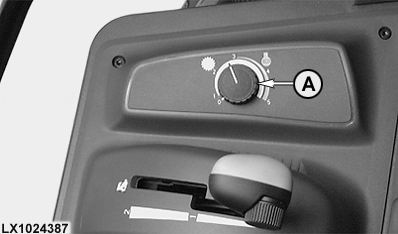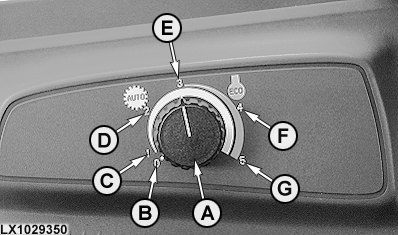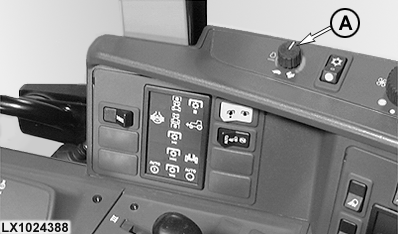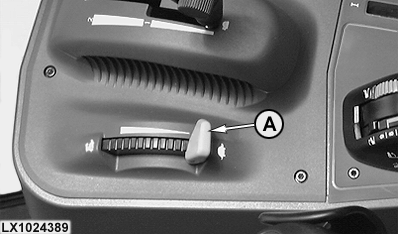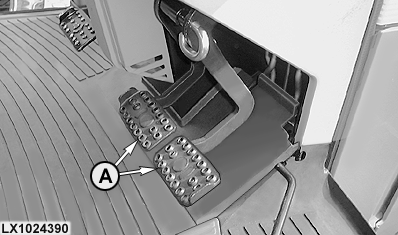JD IVT OperationReverse drive leverTo drive the tractor, move the lever to Forward (B) or Reverse (D). If the lever is moved from Forward or Reverse back to the scroll position (F), the tractor will continue to roll and the transmission goes to its PowerZero mode. Ten seconds after the tractor stops rolling, the park lock will automatically engage. If the lever is moved from Forward or Reverse directly to the park position (E), the tractor will brake to a stop using the transmission. The park lock will then engage. On bumpy terrain, remember to actuate the brake pedals as well. If the lever is moved from Forward or Reverse to the PowerZero position (C), the tractor will continue to roll but it will not be braked by the transmission. When the tractor is stationary, powerflow remains at the transmission. To obtain PowerZero, you must hold the lever firmly in this position. If the lever is released from the PowerZero position, it will automatically go to the scroll position (F). When the tractor is stopped, move the lever back to the park position. If you move it to neutral (A), the direction clutches are opened and there will be no powerflow in the transmission. The tractor may roll away. |
|
OU12401,0000C00 -19-01JAN03-1/10 |
|
Speed control lever
Travel speed is regulated using the speed control lever. Two speed ranges are available. Speed band 1 allows a maximum forward speed of 20 km/h (12.4 mph). Speed band 2 allows a forward travel speed to be set equal to the maximum tractor speed (40 km/h; 25 mph). The maximum speed in band 1 is always the minimum speed in band 2. In other words, there is no change in speed when ranges are changed. The maximum speed in a speed band is adjusted using set speed adjuster (B). For this, the engine must be running and the reverse drive lever must be in one of the following positions:
|
|
OU12401,0000C00 -19-01JAN03-2/10 |
|
The maximum speed setting of a band is reached with the engine at full throttle and the speed control lever at the end of its travel in the speed range. If the accelerator pedal is not at the end of its travel, the tractor will move at a corresponding speed (not proportional). If the speed control lever is not at the end of its travel in a speed range, the tractor will similarly operate at a corresponding speed as indicated by the red needle (C). Set speed adjuster (B) does not have a stop and can be "infinitely" adjusted. It makes a change in relation to the previous setting. If the maximum speed setting is changed with adjuster (B) while the tractor is moving, the change is always based on the last setting. Turning the adjuster will directly increase or decrease the last maximum speed setting. Creeper modeIf a forward travel speed below 2 km/h (1.24 mph) is used in speed range 1, the tractor will automatically shift to creeper mode. The possible minimum travel speed is 0.05 km/h (0.03 mph). The maximum speed in range 2 is 2.5 times greater than in range 1. In both speed ranges, the maximum speed in creeper mode is 2.5 times greater than the minimum speed. For example, if a maximum speed of 0.50 km/h (0.33 mph) is set in range 1, the minimum speed is 0.20 km/h (0.12 mph). At speeds below 0.6 km/h (0.37 mph), changing engine speed does not have any effect on travel speed. The following occurs if the speed-adjusting wheel is used to increase travel speed while the tractor is in motion in range 2 with creeper mode selected:
|
|
OU12401,0000C00 -19-01JAN03-3/10 |
|
|
OU12401,0000C00 -19-01JAN03-4/10 |
The IVT selector (A) provides two automated productivity functions:
NOTE: For most applications, maximum productivity and fuel economy is realized when IVT selector is in positions 1-5. |
|
OU12401,0000C00 -19-01JAN03-5/10 |
Positions 1 to 3: Most PTO, Loader and High-Flow Hydraulic Applications Positions 1 to 3 vary the amount of rpm the engine is allowed to pull down under load before the transmission automatically reduces ground speed. This can be adjusted based on application. For most PTO and loader applications, positions 2 to 3 will be used. Position 1 allows a 30% reduction in engine speed prior to transmission automatically reducing ground speed. Position 2 allows an 18% reduction in engine speed prior to transmission automatically reducing ground speed. Position 3 allows a 5% reduction in engine speed prior to transmission automatically reducing ground speed. Positions 3 to 4: Plowing and Tillage Operating under load: Positions greater than 3 to 4 allow a 12% reduction in engine speed prior to transmission automatically reducing ground speed. Operating under light load or no load: Selected ground speed will be maintained while engine speed automatically reduces as follows: Positions 4 to 5: Transport and Light Tillage Operating under load: Positions greater than 4 to 5 allow a 12% reduction in engine speed prior to transmission automatically reducing ground speed. Operating under light load or no load: Selected ground speed will be maintained while engine speed automatically reduces to a minimum of 1200 rpm at position 5. Position OFF: Transmission will not shift automatically to maintain engine rpm with varying loads. |
|
OU12401,0000C00 -19-01JAN03-6/10 |
|
Use OFF position if application is causing undesired automatic shifting. |
|
OU12401,0000C00 -19-01JAN03-7/10 |
Maximum engine speed can be limited for PTO operation by means of cruise control (A). Move the hand throttle lever to full throttle, set the cruise control to position 1 - 3 as required, then reduce engine speed by turning cruise control (A). In the lowest setting, engine speed is limited to 1100 rpm. In the highest setting, the engine can run at maximum speed. Individual engine speed limits can be set between these two positions. If no PTO operation is taking place, cruise control (A) should be in the "Off" position. Travel speed remains constant regardless of any engine speed limitation. |
|
OU12401,0000C00 -19-01JAN03-8/10 |
The stronger signal is always used for transmission control. If the accelerator pedal or hand throttle are moved to command a higher engine speed, engine speed increases. In Eco mode, once the set travel speed is reached, engine speed is reduced again (load controlled). If the reverse drive lever is in Forward or Reverse, the tractor can be accelerated to the set speed using the accelerator pedal or hand throttle. The immediate travel speed is directly dependent on the setting of the accelerator pedal or hand throttle. Engine speed is only indirectly determined by the position of the accelerator pedal. Thus when using the accelerator pedal or hand throttle, the values set with the JD IVT selector and cruise control are always taken into consideration. Therefore, the value set using the cruise control cannot be exceeded even at full throttle. In Eco mode, the engine turns only as fast as needed, even if the operator applies full throttle. |
|
OU12401,0000C00 -19-01JAN03-9/10 |
If when driving the tractor both brake pedals are depressed, the tractor's speed will be reduced until it stops. Thanks to the AutoClutch function, there is no need to depress the clutch pedal when braking. When the brakes are released again, the tractor automatically accelerates up to the speed currently commanded by the hand throttle or accelerator pedal. The higher the engine speed, the greater is the force required at the brake pedals to stop the tractor.
Clutch pedal The clutch pedal normally does not need to be depressed to stop the tractor. If the clutch pedal is depressed, the corresponding clutch signal has priority over other commands. |
|
OU12401,0000C00 -19-01JAN03-10/10 |
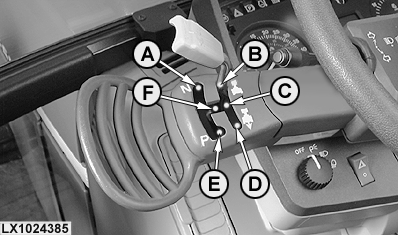
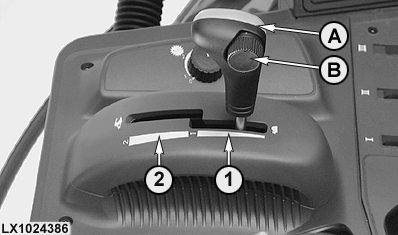
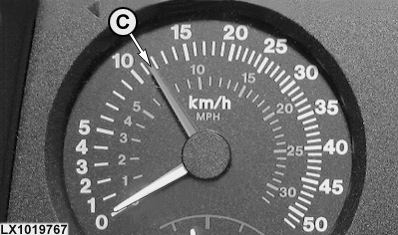
 CAUTION:
Avoid possible injury from unexpected acceleration. When load is reduced, tractor will resume selected set speed.
CAUTION:
Avoid possible injury from unexpected acceleration. When load is reduced, tractor will resume selected set speed.
